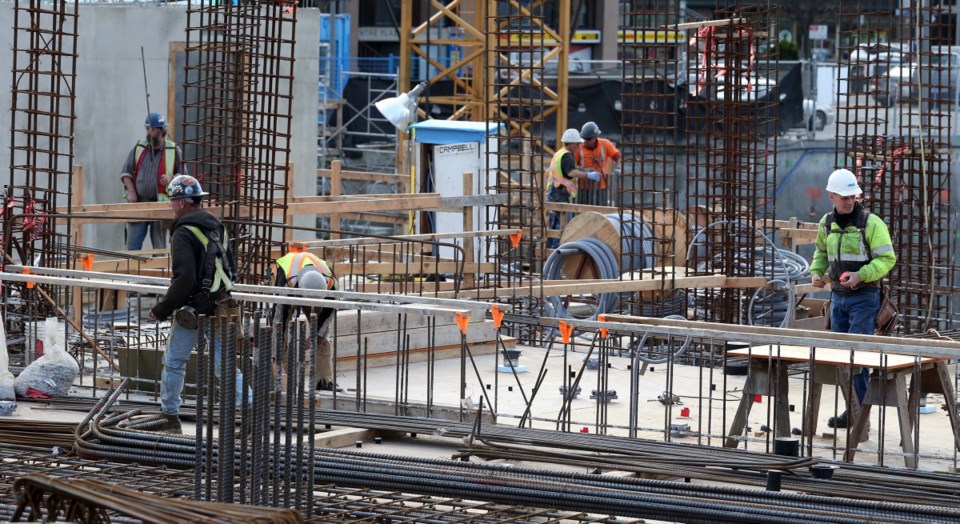The drop in oil prices and the resulting economic downturn in Alberta has been a boon for Vancouver Island construction firms according to a new study by the B.C. Construction Association.
A survey of companies and individual workers showed that over the last year 57 per cent of the Island’s construction companies have hired workers directly from Alberta’s oil and gas sector. Across B.C., 45 per cent of construction firms have done the same.
“There was a large number of people commuting to northern Alberta from out of Nanaimo and the Comox Valley,” said Greg Baynton, chief executive of the Vancouver Island Construction Association. “Now those people are looking for employment here. Look around, things in B.C. are going pretty well and our outlook is pretty encouraging.”
The Canadian Association of Oilwell Drilling Contractors estimates that 100,000 direct and indirect oil sector workers have lost their jobs across Canada in the economic downturn — most of them in Alberta, where the unemployment rate reached 7.4 per cent in January, up from 4.6 per cent a year earlier.
Baynton said by comparison there’s a lot happening on the Island in both the residential side of the business and the industrial and commercial side and companies are hungry for skilled trades.
Casey Edge, executive director of the Victoria Residential Builders’ Association, said having lost tradespeople to Alberta during the boom years of high oil prices, builders are happy to see them coming back.
Edge said the Victoria labour market is getting tighter. As conditions start to improve — including an estimate that there will be 2,000 housing starts this year alone — all hands will be needed. “What I’m hearing is there has been some hiring of some trades from Alberta, not in big numbers, but most of them will likely be going to commercial contractors first because they will have worked in the oil patch,” he said.
Manley McLachlan, president of the provincial construction association, said the number of oil patch workers being hired in B.C. is indicative of a new economic reality. “What it demonstrates, probably more strongly than what we’ve seen before is that Western Canada is evolving into what I’d call an economic zone,” he said of B.C., Alberta and Saskatchewan.
McLachlan sees the development as highly positive as the moveable labour force tends to be skilled and can step into jobs that are being vacated by retiring senior tradespeople.
“Two in three workers in B.C. are over 45 years old, and we know there are 15,000 to 16,000 eligible to retire in the next short while,” McLachlan said, noting those people tend to be company foremen, lead hands and superintendents. “They are the ones who do the training of apprentices on the job site. They are the ones in the company that keep productivity up.
“If we can draw people back to B.C. from Alberta who have a good skill set, they can plug into those jobs and the likelihood of having a big gap in productivity will be mitigated.”
McLachlan said there is demand for skilled carpenters, electricians, plumbers, welders, heavy equipment operators, roofers and other trades for industrial, commercial and highrise residential projects.
The province’s construction sector estimates there will be a labour gap of about 15,000 people by 2024, and programs in schools are a long way from filling the gap.
The construction association’s survey found that one in 70 high school students now goes into the trades, a 15 per cent improvement from 2014 when it was one in 85.
“I believe we are making headway,” said McLachlan. But the number needs to be one in five to deal with the looming gap, he said. “Moving the dial as much as we have in one year is substantial, but the job isn’t done. It will take a concerted effort and sustained investment at the high-school level and at the apprenticeship level to make things happen. We are not out of the woods here.”
McLachlan said the improvement is down to a new focus from the province with its skills for jobs program, increased apprenticeship funding and the construction association’s effort to raise $4 million for new tools for shop classes last year.
But Tom Sigurdson of B.C. Building Trades said the construction association’s employment forecast isn’t as good as it appears. He said hundreds of construction tradespeople lined up at job fairs for the B.C. Hydro Site C project in Fort St. John, and that many building trades organizations in B.C. are reporting unemployment rates of 10 per cent or more.
“We are experiencing higher levels of unemployment than we have in the past without having a lot of projects on the books, indicating that we are going to have high levels of employment in the spring and summertime,” Sigurdson said. Some unionized skilled trades people in B.C. will be heading to Alberta this spring for maintenance operations on energy projects, he said.
To compete, McLachlan said B.C. companies have to pay well and establish better work environments. That may start with wages.
The construction association survey showed 50 per cent of employers offered higher wages than they did a year ago. According to the survey, the average annual salary of a B.C. construction industry worker is $56,170.
— With a file from Canadian Press



